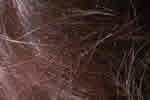Head Lice
Head Lice in schools (Pediculus Capitis)  Head lice may be eradicated in schools if correct procedures are in place. Many prescription and OTC products will remove head lice from an individual. However re-infestations are common. Why is this you may ask?We offer an onsite service and advice to schools.
Head lice may be eradicated in schools if correct procedures are in place. Many prescription and OTC products will remove head lice from an individual. However re-infestations are common. Why is this you may ask?We offer an onsite service and advice to schools.
Head lice (pediculus capitis) are animal parasites (living off a human host). These grey coloured, wingless, six legged creatures measure 1.0-3.0 mm, They are usually found near the hairline at the nape and around the ears. They require warmth and a source of human blood to survive. The female may produce a total of 300 ova in a lifetime (9-12 per day). The louse possesses a flattened jointed body with jointed limbs (Arthropoda), each leg is equipped with a claw by which it clings to hair shafts. It has two antennae.
Infestations occur without regard to social status or levels of personal cleanliness. Long haired female children within crowded environments are at greatest risk. Fastidiously clean hair provides no immunity to infestation. Adults are significantly less vulnerable to infestation.
Transmission is mainly by direct contact – head to head, sharing head wear, combs and brushes. Head lice survive on combs brushes, chair backs, hats, scarves for up to 48 hours. As they do not survive off-host beyond this period, fumigation or spraying premises is probably unnecessary.
The Pediculus ‘welds’ it’s Ova (egg or ‘nit’) onto the hair shaft approx. 2-4 mm above scalp level. Ova hatch within 5-8 days. The vacated ‘shell’ remains attached to the hair shaft and becomes increasingly distanced from scalp level due to hair growth at the nominal 1-2 cm per month.
Ova cannot be removed by shampooing, but may sometimes be combed off the hair shaft at its distal end.
Symptoms: irritation scratching and possible secondary bacterial infection.
Treatment
There are different classes of parasiticides which act on the central nervous system of the louse. Infestation may respond to chemical treatments formulated either as creams, shampoos, or lotions. Over the counter medicines are usually satisfactory (e.g. the permethrin based products). A head lice repellent containing Piperonal 2% (Rappell) is available. Hedrin suffocates the louse. Take advice regarding such local treatment from a registered pharmacy/trichologist/healthcentre/school nurse. Handle these chemicals with care as they are also inherently toxic to humans. Consult a doctor before using these medicines on infants or during pregnancy.
Alternative: Try daily applications of heavy creamy conditioners and thorough (30 minute) combings with a fine tooth-comb to dislodge the creatures preferably over a basin.
As re-infestation requires just one hidden egg to hatch, continue this daily procedure for several weeks after the last creature has been thus removed.
Thorough treatment of an infested person may involve the removal of all clothing, and treating the person with the parasiticide. All family members may be treated on the same day and subsequently as recommended to control any lice hatching. Clothes and bedclothes should be isolated in plastic bags for 14 days, then dry cleaned.
Alternative: Place items in a freezer. Freezing for a minimum period of six hours is lethal to ova and lice.
Very short hair reduces the probability of infestation / re-infestation.
